Mozilla-Based Applications
Mozilla-based applications are different than all other project types. All Mozilla-based applications have the following characteristics in common:
- They store configuration data in one (or two) files:
prefs.jsanduser.js - Those data files are stored within a randomly generated folder name in
%appdata%\<application directory>\Profiles - That folder name is pointed to by the file named profiles.ini which lives in
%appdata%\<application directory>
For instance, on this computer with Firefox installed (Figure 205), we can open the
%appdata%\Mozilla\FireFox\ folder, open the Profiles.ini file, and learn that this specific
machine will store user settings within \Profiles\edk2qe8w.default.
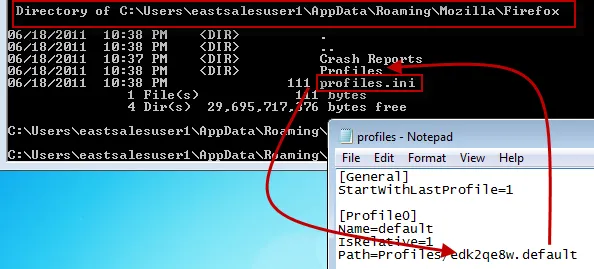
Figure 205. The location where using settings will be stored.
Every machine on your network will have a storage location, meaning Firefox (or Thunderbird,
Seamonkey, or Evergreen profiles) is stored in a unique directory on each computer. You can see in
Figure 206 the random directory name, and inside it, the prefs.js file, which defines the Firefox
settings.

Figure 206. The prefs.js file location.
The good news is Endpoint Policy Manager DesignStudio and the Endpoint Policy Manager Application Settings Manager CSE can handle this problem. Endpoint Policy Manager Application Settings Manager can deliver Firefox settings (or Thunderbird, Seamonkey, or any Mozilla-based application's settings) to that unique directory, regardless of where it lives. To do this, we have to understand the following three files:
profile.ini: This file lives within the Mozilla application name. It points to the random directory where the user data is to be stored.prefs.js: This is the baseline configuration for an application and is usually auto-populated by the application.user.js: This file is not normally present. If it is present, the settings here override theprefs.jssettings. This is to be stored in the same directory asprefs.jsand takes the same form asprefs.js.
To control Mozilla-based applications using Endpoint Policy Manager Application Settings Manager and
Endpoint Policy Manager DesignStudio, we only need to teach DesignStudio where the profiles.ini file
lives. This file is not the file that contains our user settings. This is the file that points us to
where the user settings (prefs.js) are stored (see Figure 207).
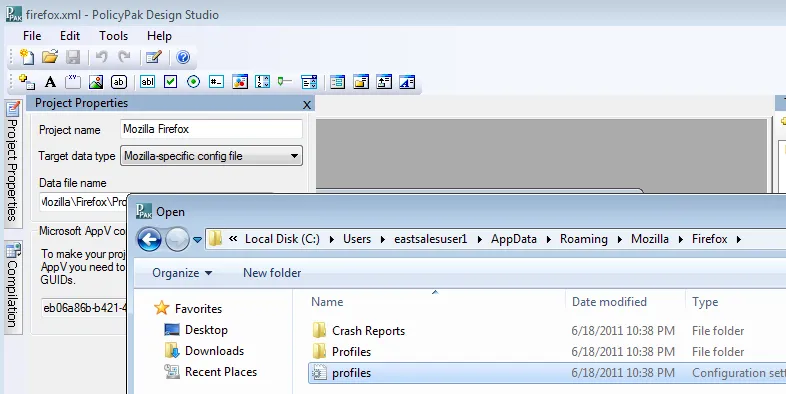
Figure 207. The profiles.ini file.
In Endpoint Policy Manager DesignStudio, for all other file-based project types (INI, XML,
.properties, .js-type, etc.), you can select the specific file you want to manage. But with Mozilla
project type files, you must always point to the profiles.ini file of the Mozilla application. For
example, with Firefox, you will likely want to specify what's shown in Figure 208. This is because
the profiles.ini file for Firefox lives in %appdata%\Mozilla\Firefox.
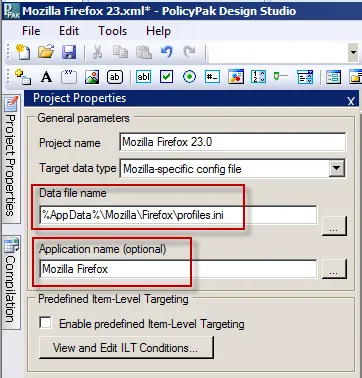
Figure 208. Pointing to the profiles.ini file location.
Note also that the "Application name (optional)" field is filled in as "Mozilla Firefox." The "Application name (optional)" field is different than the project name. "Project name" is the Endpoint Policy Manager Application Settings Manager "displayname." This is what's shown in the MMC when you indicate you want to use a new AppSet.
The "Application name (optional)" field is what is used to perform the Firefox-style UI lockout.
Endpoint Policy Manager Application Settings Manager looks in the MSI installed table for a match
like *{string}*. Therefore, its best to make the "Application name (optional)" field text more
generic.
So, in the example in Figure 209, it is specified as "Mozilla Firefox," which will be generic enough to cover all versions of Mozilla Firefox.
A common mistake is to add a string in this field that is too specific. For instance, putting "Mozilla Firefox 23.0" in this field means that this AppSet's Firefox-specific lockdown features will apply only when a product matching *Mozilla Firefox 23.0* is found on the machine.
This same idea applies to Thunderbird, Chatzilla, and all other Firefox-type applications. For
Thunderbird, the right data file location is %appdata%\Thunderbird\profiles.ini, as shown in
Figure 209. This is because the Thunderbird profiles.ini file lives in %appdata%\Thunderbird.
(Note that
Thunderbird does not contain a "Mozilla" subdirectory like Firefox). Note also that the "Application name (optional)" field should be generic enough for all version of Mozilla Thunderbird.
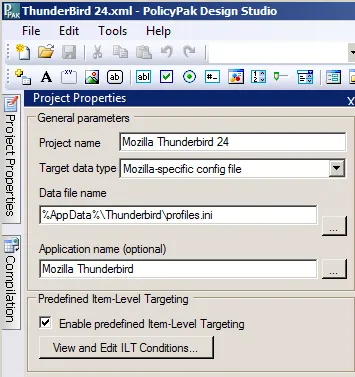
Figure 209. Filling in the "Application name" field for Mozilla Thunderbird.
For Sunbird, the location is %appdata%\Mozilla\Sunbird\profiles.ini, as shown in Figure 210. This
is because the Sunbird profiles.ini file lives in %appdata%\Mozilla\Sunbird (similar to Firefox).
The "Application name (optional)" field should be "Mozilla Sunbird" (not shown in this screenshot).
Figure 210. The location of the Sunbird profiles.ini file.
NOTE: Evergreen is a popular system for managing libraries. This application has been verified
to be a Mozilla-style application and has a profiles.ini file that you would point to.
Once Endpoint Policy Manager DesignStudio is pointing toward the profiles.ini file (and not
the prefs.js file), we are ready to perform our normal work in Endpoint Policy Manager
DesignStudio. Endpoint Policy Manager DesignStudio will use the prefs.js file on the machine you
perform the work on.
Once the AppSet is done and compiled, it's ready for use. However, when the Mozilla-based
application's AppSet is deployed to the target machine, the target machine's prefs.js is not
modified. Instead, Endpoint Policy Manager Application Settings Manager will create a new file (or
modify an existing file), named user.js. The file user.js will contain your Mozilla-based
application's settings, and will not modify the existing prefs.js.
For example, before a Mozilla-based AppSet is written to a machine, the application's folder will
usually only have a prefs.js file describing the user experience, as shown in Figure 211.
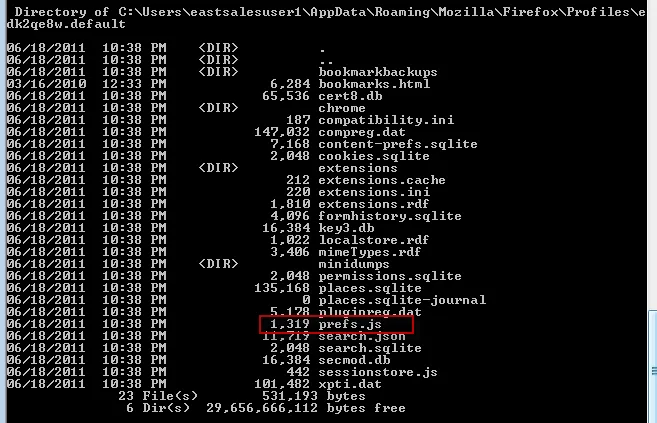
Figure 211. The prefs.js file.
After the AppSet successfully applies, Endpoint Policy Manager Application Settings Manager will
write a new file, user.js, instead of changing the prefs.js file directly. You can see the
new user.js file after the AppSet settings are deployed to Firefox on the machine in Figure 212.

Figure 212. The user.js file.
Note again that prefs.js is not touched during the delivery of the settings. The Mozilla-based
applications will treat user.js as special file that has two very important characteristics:
- If there is a conflict between the
prefs.jsand theuser.js,user.jswins. - If there is a setting defined in
user.js, and a user modifies any preference dialogs within the Mozilla-based application, they will be overwritten by theuser.jssetting.
This is perfect for Endpoint Policy Manager Application Settings Manager because you can define the
settings using Group Policy. Those settings are always written to user.js by Endpoint Policy
Manager Application Settings Manager.
If a user makes any configuration changes to Firefox, Thunderbird, etc., those changes are thrown
out if the setting is defined within user.js. For instance, if you use Endpoint Policy Manager
Application Settings Manager to define the Firefox home page, and the user changes the home page
inside Firefox, those changes are thrown away for next time.
For more information on user.js files you can check out the following web article:
http://kb.mozillazine.org/User.js_file